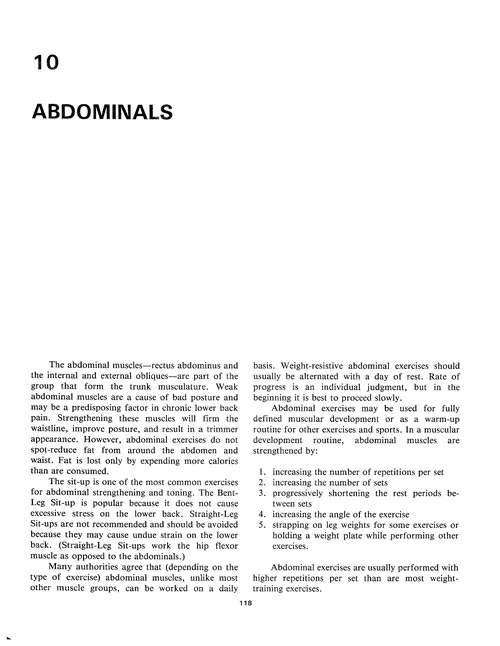
Abdominal exercises
spot-reduce fat from around the abdomen and type of exercise) abdominal muscles, unlike most beginning it is best to proceed slowly. Abdominal
adsPart of the document
10
ABDOMINALS
The abdominal muscles - rectus abdominus and
the internal and external obliques - are part of the
group that form the trunk musculature. Weak
abdominal muscles are a cause of bad posture and
may be a predisposing factor in chronic lower back
pain. Strengthening these muscles will firm the
waistline, improve posture, and result in a trimmer
appearance. However, abdominal exercises do not
spot-reduce fat from around the abdomen and
waist. Fat is lost only by expending more calories
than are consumed.
The sit-up is one of the most common exercises
for abdominal strengthening and toning. The Bent-
Leg Sit-up is popular because it does not cause
excessive stress on the lower back. Straight-Leg
Sit-ups are not recommended and should be avoided
because they may cause undue strain on the lower
back. (Straight-Leg Sit-ups work the hip flexor
muscle as opposed to the abdominals.)
Many authorities agree that (depending on the
type of exercise) abdominal muscles, unlike most
other muscle groups, can be worked on a daily
basis. Weight-resistive abdominal exercises should
usually be alternated with a day of rest. Rate of
progress is an individual judgment, but in the
beginning it is best to proceed slowly.
Abdominal exercises may be used for fully
defined muscular development or as a warm-up
routine for other exercises and sports. In a muscular
development routine, abdominal muscles are
strengthened by:
1.increasing the number of repetitions per set
2.increasing the number of sets
3.progressively shortening the rest periods be-
tween sets
4.increasing the angle of the exercise
5.strapping on leg weights for some exercises or
holding a weight plate while performing other
exercises.
Abdominal exercises are usually performed with
higher repetitions per set than are most weight-
training exercises.
118


